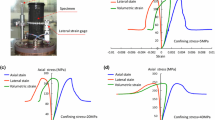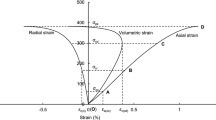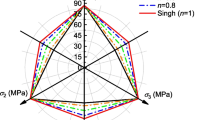Abstract
Mechanical responses of rocks to combined compression and shear have attracted increasing attention but still lack comprehensive understanding. Sixty-eight laboratory tests are conducted on basalt and granite specimens sourced from different origins to generalize the effects of specimen inclination on the mechanical properties of igneous rocks. A novel regression model is established to predict peak strength and elastic moduli of igneous specimens at various inclination angles. The model mechanically considers both the individual effect and the combined effect of independent factors. It is found that specimen inclination has nearly the same effects on the failure patterns, strength, and elastic moduli of all the experimented igneous rocks regardless of origins. Igneous rocks tend to fail in shear under combined compression and shear loading. Both their strength and elastic moduli decline approximately linearly as specimen inclination increases. The reductions of both the strength and the elastic modulus as specimen inclination increases are closely associated with the UCS (θ = 0°) and the Young’s modulus (θ = 0°), respectively. The ratio of the peak strength to the elastic modulus is an inherent property of the igneous specimen, independent of the specimen strength and inclination.










Similar content being viewed by others
Abbreviations
- a, b, c :
-
Regression coefficients (–)
- E :
-
The elastic modulus of the igneous specimen under uniaxial compression (GPa)
- E θ :
-
The elastic modulus of the igneous specimen at a given inclination angle (GPa)
- N :
-
The number of samples (–)
- R 2 :
-
The coefficient of determination (–)
- w :
-
The water content (–)
- x1, x2 :
-
The independent factors (–)
- y :
-
The dependent factor (–)
- y i :
-
The observed value (–)
- y * i :
-
The predicted value (–)
- σ c :
-
Peak strength of the igneous specimen under uniaxial compression (MPa)
- σ θ :
-
Peak strength of the igneous specimen at a given inclination angle (MPa)
- θ :
-
Specimen inclination angle (°)
- Δσ :
-
The strength reduction due to specimen inclination (–)
- C-CAST:
-
Combined compression and shear test
- FG:
-
Fujian granite
- MR:
-
Modulus ratio
- MTS:
-
Material Testing System
- NB:
-
New South Wales basalt
- NSW:
-
New South Wales
- RMSE:
-
Root-mean-square error
- SG:
-
Shandong granite
- SHPB:
-
Split Hopkinson Pressure Bar
- UCS:
-
Uniaxial compressive strength
- VAF:
-
Variance account for
- var:
-
Variation
References
Arslan AT, Koca MY, Aydogmus T, Klapperich H, Yılmaz HR (2008) Correlation of unconfined compressive strength with young’s modulus and poisson’s ratio in gypsum from Sivas (Turkey). Rock Mech Rock Eng 41:941–950
Atsushi S, Mitri HS (2017) Numerical investigation into pillar failure induced by time-dependent skin degradation. Int J Min Sci Technol 27:591–597
Azimian A, Ajalloeian R (2015) Empirical correlation of physical and mechanical properties of marly rocks with P wave velocity. Arab J Geosci 8:2069–2079
Bieniawski ZT (1967a) Mechanism of brittle fracture of rock: PART I—theory of the fracture process. Int J Rock Mech Min Sci 4:395–404
Bieniawski ZT (1967b) Mechanism of brittle fracture of rock: part II—experimental studies. Int J Rock Mech Min Sci 4:407–423
Bieniawski Z (1968) Propagation of brittle fracture in rock. In: The 10th US symposium on rock mechanics. American Rock Mechanics Association, Austin, Texas, pp 409–427
Brady BH, Brown ET (2013) Rock mechanics: for underground mining. Springer, Berlin
Cargill JS, Shakoor A (1990) Evaluation of empirical methods for measuring the uniaxial compressive strength of rock. Int J Rock Mech Min Sci 27:495–503
Chang SH, Lee CI (2004) Estimation of cracking and damage mechanisms in rock under triaxial compression by moment tensor analysis of acoustic emission. Int J Rock Mech Min Sci 41:1069–1086
Çobanoğlu İ, Çelik SB (2008) Estimation of uniaxial compressive strength from point load strength, Schmidt hardness and P-wave velocity. Bull Eng Geol Environ 67:491–498
Deere DU, Miller RP (1966) Engineering classification and index properties for intact rock. Air Force Weapons Lab. 65-116
Deliveris AV, Andreas B (2017) Evaluating performance of lignite pillars with 2D approximation techniques and 3D numerical analyses. Int J Min Sci Technol 27:929–936
Farrokhrouz M, Asef MR, Kharrat R (2014) Empirical estimation of uniaxial compressive strength of shale formations. Geophysics 79:227–233
Gokceoglu C, Zorlu K (2004) A fuzzy model to predict the uniaxial compressive strength and the modulus of elasticity of a problematic rock. Eng Appl Artif Intell 17:61–72
Hatzor YH, Palchik V (1998) A microstructure-based failure criterion for Aminadav dolomites. Int J Rock Mech Min Sci 35:797–805
Hatzor YH, Zur A, Mimran Y (1997) Microstructure effects on microcracking and brittle failure of dolomites. Tectonophysics 281:141–161
He Q, Li Y, She S (2019) Mechanical properties of Basalt specimens under combined compression and shear loading at low strain rates. Rock Mech Rock Eng. https://doi.org/10.1007/s00603-019-01806-8
Hoek E, Bieniawski ZT (1965) Brittle fracture propagation in rock under compression. Int J Fract 1:137–155
Hudson JA, Brown ET, Fairhurst C (1972) Shape of the complete stress–strain curve for rock. In: 13th US symposium on rock mechanics. American Society of Civil Engineers, New York, pp 773–795
Jamshidi A, Nikude MR, Khamehchiyan M (2014) Investigating the effect of specimen diameter size on uniaxial compressive strength and elastic properties of travertines. J Sci Islamic Repub Iran 25:133–141
Jamshidi A, Nikudel MR, Khamehchiyan M, Sahamieh RZ (2016a) The effect of specimen diameter size on uniaxial compressive strength, P-wave velocity and the correlation between them. Geomech Geoeng 11:13–19
Jamshidi A, Nikudel MR, Khamehchiyan M, Zarei Sahamieh R, Abdi Y (2016b) A correlation between P-wave velocity and Schmidt hardness with mechanical properties of travertine building stones. Arab J Geosci 9:568
Jamshidi A, Zamanian H, Sahamieh RZ (2018) The effect of density and porosity on the correlation between uniaxial compressive strength and P-wave velocity. Rock Mech Rock Eng 51:1279–1286
Kahraman S (2001) Evaluation of simple methods for assessing the uniaxial compressive strength of rock. Int J Rock Mech Min Sci 38:981–994
Katz O, Reches Z, Roegiers JC (2000) Evaluation of mechanical rock properties using a Schmidt Hammer. Int J Rock Mech Min Sci 37:723–728
Ma T, Wang L, Suorineni FT, Tang C (2016) Numerical analysis on failure modes and mechanisms of mine pillars under shear loading. Shock Vib 2016(6195482):1–14. https://doi.org/10.1155/2016/6195482
Mallı T, Yetkin ME, Özfırat MK, Kahraman B (2017) Numerical analysis of underground space and pillar design in metalliferous mine. J Afr Earth Sci 134:365–372
McClintock FA, Walsh JB (1963) Friction on Griffith cracks in rocks under pressure. In: The 4th US congress on applied mechanics. American Society of Mechanical Engineers, New York, pp 1015–1021
Nicksiar M, Martin CD (2014) Factors affecting crack initiation in low porosity crystalline rocks. Rock Mech Rock Eng 47:1165–1181
Nie X, Chen WW, Sun X, Templeton DW (2007) Dynamic failure of borosilicate glass under compression/shear loading experiments. J Am Ceram Soc 90:2556–2562
Ocak I (2008) Estimating the modulus of elasticity of the rock material from compressive strength and unit weight. J South Afr Inst Min Metall 108:621–626
Palchik V (1999) Influence of porosity and elastic modulus on uniaxial compressive strength in soft brittle porous sandstones. Rock Mech Rock Eng 32:303–309
Palchik V (2007) Use of stress–strain model based on Haldane’s distribution function for prediction of elastic modulus. Int J Rock Mech Min Sci 44:514–524
Palchik V (2011) On the ratios between elastic modulus and uniaxial compressive strength of heterogeneous carbonate rocks. Rock Mech Rock Eng 44:121–128
Palchik V, Hatzor YH (2002) Crack damage stress as a composite function of porosity and elastic matrix stiffness in dolomites and limestones. Eng Geol 63:233–245
Palchik V, Hatzor YH (2004) The influence of porosity on tensile and compressive strength of porous chalks. Rock Mech Rock Eng 37:331–341
Rohde J, Feng H (1990) Analysis of the variability of unconfined compression tests of rock. Rock Mech Rock Eng 23:231–236
Sachpazis CI (1990) Correlating Schmidt hardness with compressive strength and Young’s modulus of carbonate rocks. Int J Rock Mech Min Sci 28:75–83
Sarkar K, Vishal V, Singh TN (2012) An empirical correlation of index geomechanical parameters with the compressional wave velocity. Geotech Geol Eng 30:469–479
Shalabi FI, Cording EJ, Al-Hattamleh OH (2007) Estimation of rock engineering properties using hardness tests. Eng Geol 90:138–147
Sharma PK, Singh TN (2008) A correlation between P-wave velocity, impact strength index, slake durability index and uniaxial compressive strength. Bull Eng Geol Environ 67:17–22
Sonmez H, Tuncay E, Gokceoglu C (2004) Models to predict the uniaxial compressive strength and the modulus of elasticity for Ankara Agglomerate. Int J Rock Mech Min Sci 41:717–729
Sun X, Liu W, Chen W, Templeton D (2009) Modeling and characterization of dynamic failure of borosilicate glass under compression/shear loading. Int J Impact Eng 36:226–234
Suorineni FT (1998) Effects of faults and stress on open stope design. University of Waterloo, Waterloo
Suorineni FT, Kaiser PK, Mgumbwa JJ, Thibodeau D (2013) Mining of orebodies under shear loading part 1—case histories. Min Technol 120:137–147
Suorineni F, Mgumbwa J, Kaiser P, Thibodeau D (2014) Mining of orebodies under shear loading part 2–failure modes and mechanisms. Min Technol 123:240–249
Ulusay R (2014) The ISRM suggested methods for rock characterization, testing and monitoring: 2007–2014. Springer, Berlin
Vásárhelyi B (2005) Statistical analysis of the influence of water content on the strength of the Miocene limestone. Rock Mech Rock Eng 38:69–76
Walsh JB (1965) The effect of cracks on the uniaxial elastic compression of rocks. J Geophys Res 70:399–411
Wang H, Poulsen BA, Shen B, Xue S, Jiang Y (2011) The influence of roadway backfill on the coal pillar strength by numerical investigation. Int J Rock Mech Min Sci 48:443–450
Wawersik W, Fairhurst C (1970) A study of brittle rock fracture in laboratory compression experiments. Int J Rock Mech Min Sci 7:561–564
Xu Y, Dai F (2018) Dynamic response and failure mechanism of brittle rocks under combined compression-shear loading experiments. Rock Mech Rock Eng 51:747–764
Xu S, Huang J, Wang P, Zhang C, Zhou L, Hu S (2015) Investigation of rock material under combined compression and shear dynamic loading: an experimental technique. Int J Impact Eng 86:206–222
Yao Q, Li X, Zhou J, Ju M, Chong Z, Zhao B (2015) Experimental study of strength characteristics of coal specimens after water intrusion. Arab J Geosci 8:6779–6789
Yasar E, Erdogan Y (2004) Correlating sound velocity with the density, compressive strength and Young’s modulus of carbonate rocks. Int J Rock Mech Min Sci 41:871–875
Yilmaz I (2010) Influence of water content on the strength and deformability of gypsum. Int J Rock Mech Min Sci 47:342–347
Yılmaz I, Sendır H (2002) Correlation of Schmidt hardness with unconfined compressive strength and Young’s modulus in gypsum from Sivas (Turkey). Eng Geol 66:211–219
Zhao PD, Lu FY, Chen R, Sun GL, Lin YL, Li JL, Lu L (2010) A new technique for combined dynamic compression-shear test. In: Proulx T (ed) Proceedings of the SEM annual conference. Springer, New York, Indianapolis, Indiana USA, pp 417–424
Zhao PD, Lu FY, Lin YL, Chen R, Li JL, Lu L (2012) Technique for combined dynamic compression-shear testing of PBXs. Exp Mech 52:205–213
Zhou XP, Bi J (2016) 3D numerical study on the growth and coalescence of pre-existing flaws in rocklike materials subjected to uniaxial compression. Int J Geomech 16:04015096
Acknowledgements
The work of this paper is financially supported by the Jiangsu Province Science Foundation for Youths (Grant Number: BK20180658), State Key Laboratory of Water Resource Protection and Utilization in Coal Mining (Grant Number: SHJT-17-42.11), State Key Laboratory of Coal Resources and Safe Mining (Grant Number: SKLCRSM18X009), and China Postdoctoral Science Foundation (Grant Number: 2018M632422). The authors would like to acknowledge Professor Fidelis Suorineni for his contribution to developing the C-CAST system and the postgraduate students at China University of Mining and Technology for their involvement in the laboratory experiments.
Author information
Authors and Affiliations
Corresponding authors
Ethics declarations
Conflict of interest
The authors declare that they have no conflict of interest to this work.
Additional information
Publisher's Note
Springer Nature remains neutral with regard to jurisdictional claims in published maps and institutional affiliations.
Rights and permissions
About this article
Cite this article
He, Q., Li, Y., Xu, J. et al. Prediction of Mechanical Properties of Igneous Rocks Under Combined Compression and Shear Loading Through Statistical Analysis. Rock Mech Rock Eng 53, 841–859 (2020). https://doi.org/10.1007/s00603-019-01948-9
Received:
Accepted:
Published:
Issue Date:
DOI: https://doi.org/10.1007/s00603-019-01948-9




